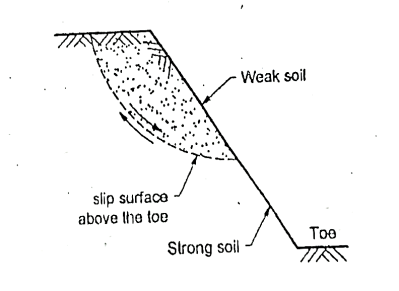Unit - 6
Stability of Slopes
Actuating force
Slip surface
Key Takeaways:
In case of slopes may be artificial or natural, the force exist which tend to cause the soil to move from high points to low points then it is termed as stability of slopes.
Slopes are classified as follows:
1. Infinite slope:

Fig.6.1: An infinite slope
2. Finite slopes:

Fig.6.2: Embankment

Fig.6.3: Cut slope
3. Homogeneous slopes:
4.Non-Homogenous slopes:
Key Takeaways:
Slopes are classified as follows:
Modes of failure in Infinite slopes

Fig.6.4: failure in infinite slope
Modes of failure in Finite slopes
1. Face failure or slope surface

Fig.6.5: Plane side of Face failure

Fig.6.6: Rotational side of face failure
2. Toe failure

Fig.6.7: Plane side of Toe failure

Fig.6.8: Rotational side of toe failure
3. Base failure

Fig.6.9: Modes of base failure
Key Takeaways:
1.Modes of filure in infinite slopes
2.Modes of failure in Finite slopes:
There are three basic modes of failure in case of finite slopes.
Stability of slopes is determined by following methods:
6.4.1 Taylor’s Stability Number:

∴Weight of the wedge  H2
H2
We know,
=
= =Sn …. (1)
=Sn …. (1)

Cm= … (2)
… (2)
Where C= Cohesion:
(F.S) c= Factor of safety with respect to cohesion
Hence the Equation (1) can be written as follows:
Sn = =
= …. (3)
…. (3)
∴ (F.C) c =Hc/H… (4)
Where (F.C) c = Factor of safety with respect to cobesion
There Equation (3) becomes as
Sn = =
= … (5)
… (5)


Fig.6.10: Taylor’s stability number charts, =0 with respect to depth factor
=0 with respect to depth factor
6.4.2 Swedish Slip Circle method:
6.4.3 Friction Circle Method:
6.4.4 Bishop’s Method:
Key Takeaways:
Stability of slopes is determined by following methods:

Fig.6.11: Infinite slope with a prism of soil
Horizontal length of prism 'abcd' of soil = 
Volume per unit length of prism=
Weight of prism (W) =
Vertical stress acting on the surface RS=w/l= /l
/l

Vertical stress is resolved into two stress components which are normal components and tangential components to the surface 'RS'.
Normal components =
and Tangential components= t=
t=
Here tangential components are termed as shear stress which develops the failors along "RS" and resisted by the shear strength of the soil.
F. S=
Where, F.S =Factor of safety of slope
 =Shear strength
=Shear strength
 = Shear stress
= Shear stress
Key Takeaways:
For an infinite slope, Soil properties and soil stress on any plane parallel to the slope surface are identical. Sliding of a soil mass along a plane parallel to slope is the failure of slope due to identical soil.
Definition:
The term "landslide" describes a wide variety of processes that result in the downward and outward movement of slope-forming materials including rock, soil, artificial fill, or a combination of these. The materials may move by falling, toppling, sliding, spreading, or flowing.
Types of Landslides:
Slides:
Falls:
6.6.1 Causes of Land Slides:
11. Morphological Causes
12. Human Causes
6.6.2 Remedial of Landslides:
Key Takeaways:
Landslides can be termed as a wide variety of processes that result in the downward and outward movement of slope-forming materials including rock, soil, artificial fill, or a combination of these.
References: